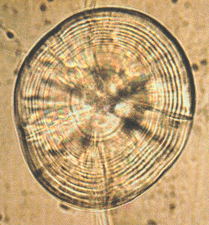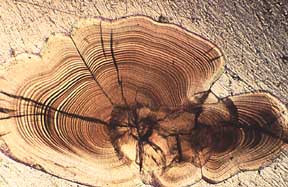Microstructure and Daily Increments
Teleost fish otoliths deposit growth increments with a daily periodicity (hence the term "daily ring"), thus providing precise age and growth information through much of the first year of life. The formation of daily increments appears to be ubiquitous across all species and in all environments, and the appearance of the increments is often more distinct than that of annuli. As a result, otolith microstructure examinations revolutionized studies of young fish through the 1980's, and have now become routine in many fisheries laboratories around the world.
The factors responsible for daily increment formation have been well studied, and are summarized in Campana and Neilson (1985). In brief, the increments form as a result of an endogenous circadian rhythm, or internal clock, which is initially entrained by a 24-hour light-dark cycle. The light-dark cycle is not required for daily increment formation after entrainment. Environmental fluctuations such as feeding, activity and in particular temperature variations, can all interact to produce increments in addition to those of the daily cycle: these are often referred to as subdaily increments. However, the environmental cycles more often serve to reinforce the endogenous daily cycle, thus producing clear and regularly-spaced increments in natural environments. The only instances where daily increments do not appear to form each and every day is under conditions of poor growth and in adult fishes.
Studies of the otolith microstructure provide much more than just age and growth information. Since the date of fish death (corresponding to the outermost increment in the otolith) is known, the number of daily increments can be used to calculate the exact date of hatch. Hatch date frequencies in turn can be used to estimate spawning times, based only on collections of juveniles. The ages and dates of certain life history events (eg- metamorphosis from the larva to the juvenile) are also recorded in the microstructure, through a change in increment width and appearance.
And since otolith growth is often proportional to fish growth, the width of a daily increment is roughly proportional to the growth of the fish on that day. Such growth backcalculations are powerful applications of the otolith, and are often used to reconstruct the daily growth history in relationship to the environment. Other applications include studies of recruitment, mortality rate and thermal mass marking. Indeed, the otolith microstructure can generally be used to provide date- or age-structured information to any application, including probe-based elemental analyses. These and other applications are described in detail in Campana and Jones (1992).
All microstructural examinations are directed towards a view of the internal structure. In very small otoliths (eg- those less than 40 µm in diameter), simple microscopic examination on a glass slide may be sufficient. However, some form of otolith preparation is generally required. This can take the form of polishing to remove surface material, or embedding and sectioning. The end product in both cases is a cross section of the otolith. Examination of the growth increments is always made with a compound microscope, since increment widths are generally less than 10 µm.
The information that can be gained from examination of the otolith microstructure of a young fish is immense. However, the learning curve for preparing and interpreting the otoliths should not be underestimated: it is time-consuming. We strongly recommend the book Otolith Microstructure Examination and Analysis, by Stevenson and Campana, as an all-in-one guide to the field. This book can be downloaded, and additional methodological instructions viewed, on the following page: Otolith Microstructure Methods

